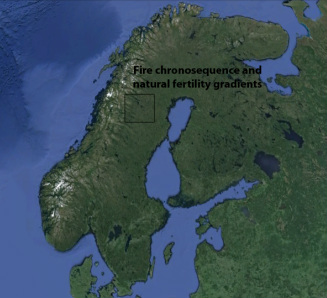Field study sites

The project is being performed in subarctic boreal ecosystems where feathermoss carpets dominate the forest floor and fire remains the primary disturbance mechanism. All forest sites are dominated by Scots pine (Pinus sylvestris) or Norway spruce (Picea abies). The ground vegetation in mature stands is dominated by ericaceous dwarf shrubs (Vaccinium sp., Empetrum sp., and Calluna vulgaris (L.) Hull) and dense carpets of feather mosses, mainly Pleurozium schreberi and Hylocomium splendens.
Nitrogen fixation, turnover, and uptake studies will be conducted along three distinct N enrichment gradients:
(1) Fire chronosequence: N availability gradient
(2) Natural fertility gradients
(3) Anthropogenic N deposition gradient (from 59º N to 69ºN)
Nitrogen fixation, turnover, and uptake studies will be conducted along three distinct N enrichment gradients:
(1) Fire chronosequence: N availability gradient
(2) Natural fertility gradients
(3) Anthropogenic N deposition gradient (from 59º N to 69ºN)
Fire chronosequence: N availability gradient
Reduction of available N with time since fire. We will use the fire chronosequence sites to evaluate successional changes in N fixation as related to N uptake, turnover and greenhouse gas emissions (all WPs). Chronosequence studies will be conducted on 14 forest reserves with varied time since last fire (5 – 360 years). All chronosequence sites occur within the Northern Boreal zone of Sweden (~66ºN, ~18ºE) and consist of mixed Scots pine and Norway spruce.
View Field sites in a larger map
Natural fertility gradients
Numerous natural fertility gradients exist in northern Sweden where groundwater recharge zones deliver nutrients and moisture to the soil surface. This results in the creation of a completely unique forest composition where groundwater discharge zones are dominated by extremely large spruce and birch trees, with an understory dominated by tall herbaceous species, in contrast to the modest sized pines and dwarf shrubs of normal upland forests.
These sites occur both in northern boreal forests (66ºN, 17ºE) and have variable rates of N fixation activity apparently as a result of differential N present in throughfall. These sites are to be used in WP 3.
These sites occur both in northern boreal forests (66ºN, 17ºE) and have variable rates of N fixation activity apparently as a result of differential N present in throughfall. These sites are to be used in WP 3.
Anthropogenic N deposition gradient
Exists from southern to northern Sweden. We have established study sites (Zackrisson et al., 2009) on forest reserves within this N deposition gradient reaching from 59ºN to 69ºN. We will select fifteen of these sites that have similar forest history, soils, and physiography for use in WP 3.
